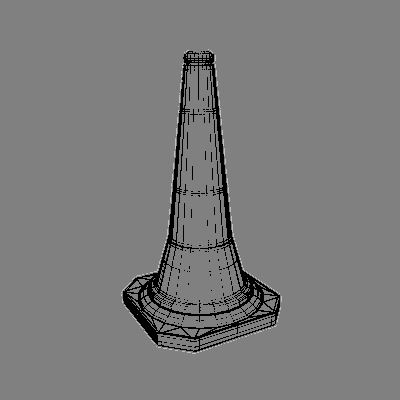
Was somewhat amused to see my handiwork on lovegifs, a tumblr site that, as explained on lalblog, is thought by some to be out of bounds in appropriating others' animated GIFs without credit.
As I explained in my post I took the frames for "my" GIF from a 3D modeling page that cpb linked to. It was three images of a traffic cone, one in full color and two stages of wire frame. They are slightly different sizes, so when put together in sequence they appear to throb. Saving them at a lower resolution altered the color scheme and contributed subtly to the throbbing effect.
It is both my work and a "remix" of other artwork(s), precisely the kind of thorny hybrid courts are so ill-equipped to judge.
Lovegifs doesn't claim to be the author, just the conduit. Apparently Lovegifs ran afoul of a complex scheme within tumblr for giving authors ultimate credit.
It's good the host has something like that in force, I guess, but with most of the tumblr sites I look at I don't have a clue who made what. Some, like Rising Tensions, have a very definite style, but I can't tell how much of what's posted there is original and am unlikely to spend a lot of time clicking flow charts on tumblr to find out the "true" source. Especially knowing that some true sources may be, like mine, a mix of made and found.
Lalblog sums up the issues well:
Though Tumblarity [a utility for gauging popularity of tumblr posts] may have nothing to do with Mogadonia's frustrations, having it there to remind you of how "successful" your work, taste and curatorial skills are makes "credit" that much more important. It's no longer just a matter of properly citing your sources, but also of giving "props", and though I empathise and respect an artist's copyright, I can't help but feel that a lot of this is based more in the ego trip of popularity.
I am by no means above this, I always revel when my "finds" get re-blogged or posted elsewhere, linking back to either here or my Tumblog, but one can't justifiably force themselves upon others by saying "I made this!" or "I found this!" when so little (especially when it comes to animated gifs) is ever found only once or by only one person. Part of the joy of the internet is the anonymity and reproducibility - success is when a gif spreads like a virus and can no longer be traced to an "original" (what and where is the original when it comes to digital material, anyway?) - it is no longer "mine" but of the internet.
Perhaps I'm being too idealistic, but what is represented as conspiracy looks to me like a show of laziness and/or a desire to have (yet another) hot new animated gif Tumblog. Lovegifs is little more than a minor symptom of the internet and, at worst, a major symptom of Tumblarity.
